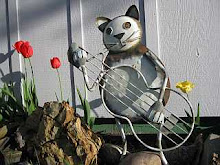 |
| The old gate was a barb wire gate. |
The new gate is 20 feet long. It is a HW brand and a brown gate, which means the tube diameter is smaller than typical but made of a stronger and heavier metal. To support the gate I used railroad ties as posts and used old boards to make a solid corner for support. I added railroad ties and boards to the other (left) side of the gate for symmetry, and to use up old boards.
I also made the corner a 'corner' to 'clean' the corner up and make it look nicer. In the past the chain link fencing hadn't quite reached the corner and I had to add a chain link gate as part of the fence and not as a gate. You can also see in the previous photo a warped board to support the end of the fence. That board predated my work on adding the chain link fencing to the fence.
Most of my railroad ties are 8 1/2 feet long and I place them 2 1/2 feet into the ground. For the tie that the gate attaches to I used a 10 foot railroad tie. I placed that tie 4 feet into the ground, for two reasons. One reason was to make the ties the same height above ground, and the other reason is a deeper tie provides more support.
While I can lift and place most 8 1/2 foot ties into the hole in the ground, the 10 foot tie was too heavy for me to lift. My tractor made it easy to lift the tie. I wish I had the tractor back when I rebuilt the loading corral. I had to get creative back then to lift those 10 foot ties into the ground. And I was younger back then.
I bought the brown gate used. The gate didn't come with bolts which didn't concern me as I have extra lag bolts. Ah... but I discovered a problem. On most gates the top hinge is adjustable. That allows the top bolt to point downward. Having the top and bottom bolts point in opposite directions prevents the cattle from lifting the gate off the bolts, which I have learned the cattle can do.
On the brown HW gates both hinges are fixed. What the brown HW gate has are bolts that have a cotter pin that goes in the bolt above the hinge to hold the gate in place. Most bolts hinge part is 1 1/4 inch tall. The brown HW hinge part is 3 inches tall. I didn't have any bolts that would work.
I called all the stores that carry HW gates, a fencing company and a hardware store. No one had a bolt with a hinge part over 3 inches tall. Not even the stores that sell brown HW gates.
Oh great.
I went to the HW web site: http://livestockequineequipment.hutchison-inc.com/item/heavy-duty-cattle-equipment/gate-hardware-2/hb800-030-0054
$34.29 for one bolt?! Plus shipping! And who knows how long it would take to be shipped to me. No thanks!
So I needed the top bolt to face down to hold the gate in place when the hinge part is less than 3 inches. Most of my bolts are screw-in bolts and would not work. I did find one pair of complete bolts where I would have to drill holes all the way through the railroad ties.
I have a wimpy battery powered drill so it took three charges to drill the two holes.
Fortunately I have a tractor so I could hold the gate in the air so that I could slide the gate and the bolts into the two holes at the same time; then bolt the gate in place.
While I bought the gate 'used' from a fencing company's bargain / repurposed area, as you can see from how the end of the chain was still welded to the tube, I doubt the previous owner ever used the gate.
Due to the length and weight of the gate, I placed a short piece of railroad tie in the ground on which to rest the gate when closed. This will help prevent gravity from warping the end of the gate downward over the years, and takes pressure off the railroad tie to which the gate is attached.
So. Another barb wire gate is replaced, which makes opening and closing the gate much easier. And this gate is more solid than the old wire gate.







No comments:
Post a Comment